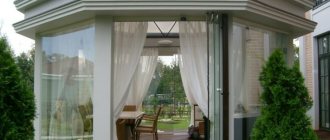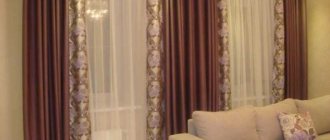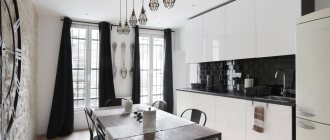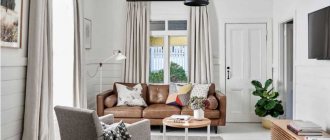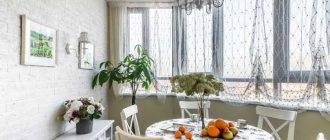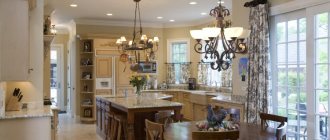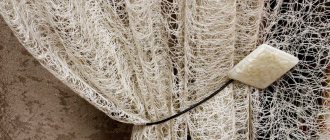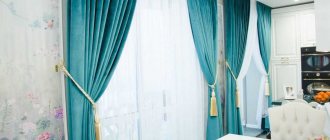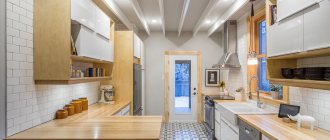Classic
They have been used for quite a long time, and every year they become more and more popular. First of all, this is due to the fact that minimalism and loft are coming back into fashion, which implies the absence of unnecessary details.
In fact, every home once had this type of curtain. Its advantage is that it fits perfectly into any style and interior. For living rooms, it is best to use more delicate, warm shades; you can add voluminous, intricate patterns.
For bedrooms, it is best to use plain, calm shades such as beige, turquoise, etc. For a children's room, it is recommended to use curtains in original colors. This will spur the child to creativity and will lift his spirits.
The classic type of curtains can be hung not only in the apartment, but also in the office. They will go perfectly with business style. Types of curtain rods are divided into several types: by fastening, by material, by appearance.
Types of curtains:
English curtains, Roman curtains, French curtains, roller blinds, panel curtains, Chinese curtains, bamboo curtains, pleated curtains, Italian curtains, blinds, winter curtains, curtains with rings or eyelets.
Curtains consist of various elements , the names of which are pleasant to the ear, but few people understand them and know their designation.
For example, parts of the diagram of elements of curtains and curtains:
1. Curtain.
2.De jabot (an element of a soft lambrequin, or a piece covered with folds of fabric, with a beveled or stepped edge).
3. Lambrequin (a decorative element made of any fabric that covers the cornice itself).
4. Swag (soft lambrequin), bando (frame form of a hard lambrequin).
5.Lining (used to give shape to curtain elements, as well as for additional support.)
6.Picking (decoration of curtains using various picking and fastening elements).
7. Bell (bell, or conical single fold)
8. Curtain.
9. Tie (a decorative element of a lambrequin, which is cut out like a frill, but laid in folds one on top of the other.
10.Mold (a strongly flared gather, just like a frill, only a symmetrical piece of lambrequin, or it is called a skirt)
11. Overhangs (lambrequins with free drapery, thrown over the cornice rod, or it is called a swag with sagging).
12. Puffs (lush folds)
13. Ruffles (folded strips of fabric or ribbons for decorative finishing of curtains or curtains).
14. Also for decorating curtains and accessories for them are: tassels, magnets, curtain braid, various loops.
I hope, knowing some elements and styles of curtains , you will be able to purchase ready-made ones or order them to your liking.
To make the most beautifully and correctly executed decorative elements of a lambrequin (svags, asymmetrical swags, crossovers, asymmetrical crossovers, swags turning into de jabot), when cutting, they use not the warp or weft thread, but the direction of the thread obliquely, i.e. at an angle of 45°, since the oblique direction of the fabric when manually laid gives a soft draped fold, which allows you to achieve the most elegant shape of the lambrequin parts.
It is also possible to produce swags, switches, etc. along the warp thread. This cut is used in the case of large sizes of parts, in the presence of a pattern that does not allow it to be turned over (stripe, pattern, monograms, etc.), in the presence of a small amount of fabric, when the part is mechanically processed (i.e. it is laid not by hand, but is collected by the assembly tape assembly factor).
Classic tie
Tie on the bias (in a spiral)
Bell
Double bell
De jabot with one-piece bell
Austrian
Austrian curtains are notable for the fact that they are a canvas assembled into beautiful horizontal folds.
To form these folds, a lace or a plastic stick is used. The mechanism is exactly the same as that of blinds, only in the upper position it is necessary to fix the canvas manually. If desired, Austrian curtains can be opened.
The most popular models are those made of silk or cambric. Fastening curtains in this case can be of several types, as in the previous case.
French
The French made a huge contribution to the development of most styles that are now very popular. All products and ideas from this country are distinguished by sophistication and delicacy, including curtains.
French curtains have a large number of subtypes, which allows you to choose the most suitable option for a specific room.
Note!
- Light green curtains - 120 photos of the most beautiful design and interior design options
Ready-made curtains - how not to make a mistake with your choice? TOP 100 photos of the best new designs
Japanese curtains in the interior: bedrooms, kitchens, living rooms. 90 photos of the best new designs
Most often they are placed in the living room or bedroom. This is due to the fact that they are made of a fairly dense material that can protect from excess sunlight and dust.
Bamboo
One of the types of roller blinds. Its peculiarity is that it is completely natural, made from bamboo. This type is made entirely by hand, which adds value.
Bamboo stems are used as the main material. The disadvantage of this type of curtains is the small number of variations available on sale. In addition, the appearance, as a rule, cannot be edited in any way, unlike classic paintings.
However, they are highly resistant to virtually any climate and provide excellent protection from the sun and dust. If desired, they can be repainted in any color; already painted models can also be found on sale. They are very easy to care for; just wipe with a damp cloth to remove dust.
Accordion curtains in the living room
This design will look good when zoning a room. If desired, you can easily remove or, conversely, install a barrier. There are also accordion doors.
Accordion curtains can be hung on windows. In another way, they are called roller blinds or pleated curtains, which have long been used instead of ordinary curtains. Due to their small size, such curtains free up a large amount of space in the room, are easy to clean and protect well from sunlight.
Roller blinds can be used not only for windows, but also for glass doors if you don’t want someone passing by to see what you’re doing. Due to their design, such models are easy to attach and do not cause any inconvenience.
Rolled
The photo of the best types of curtains shows that roller types are very popular. This is due to the fact that with their help you can greatly save free space, while they can provide excellent protection from the sun and dust. There are only 2 types: classic (width no more than 1.8 m) and luxury (width is individual).
Classic ones can be found on sale in a wide range; they are suitable for most windows. Luxury is designed for large windows, for which it is difficult to choose curtains. As a rule, they are ordered individually from the manufacturer according to their own window parameters.
Paper curtains
The beauty of this option is that you can easily make them yourself from any piece of paper you like, most often pleated wallpaper. At the same time, they will cope with their function no worse than their fabric counterparts.
The only drawback is that they cannot be washed. They are afraid of water, but they can even be hung on balconies if the windows there are protected from precipitation. Simplicity of manufacture, unlimited flight of design imagination and low cost are the main trump cards of paper curtains.
How to choose the right fabric
It is necessary to choose a fabric first of all based on the specific room in which the curtains will be located.
If this is a kitchen, it is better to give preference to light, translucent options. This is due to the fact that the kitchen, as a rule, is not located on the sunny side; there is no need for constant protection from sunlight.
Denser options are ideal for the living room and bedrooms, where it is necessary to completely isolate the room from light.
Kinds
If we talk about the types of curtains, then first of all they are divided into three huge classes:
- sliding,
- stationary,
- lifting
Sliding curtains are divided into several types:
- classic sliding curtains are thick curtains hung vertically from the eaves, and a light curtain underneath them - usually solid, consisting of one element;
- crossed curtains go criss-cross: the curtains are fixed in one corner and brought out to the other, overlapping each other and often opening with the help of a tie. A slightly rarer option is a crossed curtain made of one sheet, which is picked up by a tie on one side if you want to let light into the room;
- cafe curtains - shortened curtains that are attached to a cornice hung at the level of the middle of the window; sometimes another curtain rod is attached to the top in a standard place, on which another shortened lambrequin curtain is hung;
- Japanese screen curtains are a rigid frame that moves to one side when it is necessary to open the window. They consist of several sections, which makes them easy to manipulate by sliding one section after another. Sometimes they are located on cornices located at different levels: one deeper, closer to the window, the other further;
- muslin - this is when a lot of ribbons are simply suspended from the cornice. Their purpose is often decorative; Such muslin curtains are often hung to the doorway, and not to the window.
Stationary curtains do not move, they are firmly fixed and are used “for beauty”, and not to protect from sunlight or provide privacy. There are also several varieties of them:
- Imperial curtains are repeatedly picked up horizontally along the cornice and descend, like a girl's braid, to the floor on one side. They are not supposed to be moved; they look formal, even pompous, and are ideal for decorating a luxurious ballroom;
- The “bishop’s sleeves” are also picked up several times, but not horizontally, but vertically, so that the curtain going down to the floor really begins to resemble the sleeves of a bishop’s robe. Her goal is exactly the same as the imperial one: to make it expensive and rich;
- The “hourglass” is stretched onto the glass at the top and bottom, and in the middle is tightened with tape or braid, so that its shape begins to resemble an hourglass. Look good on verandas, terraces and galleries;
- Italian curtains are slightly reminiscent of crossed curtains, but they are usually tied closer to the top, and they are fixed in such a way that they are supposed to be untied only occasionally for washing.
Lifting curtains rise upward using various mechanisms, from ordinary cords to complex automation. What are they?
- Austrian ones do not rise entirely, but are pulled up approximately to the middle, due to which elegant folds are formed on the canvas;
- French ones are in many ways similar to Austrian ones, but if the latter, in the straightened state, are practically devoid of folds, then the French ones are distinguished by their horizontal “collection” even in the lowered position;
- Roman flat blinds (go to products) are made of thick fabric; they usually do not cover the entire window, but only the glass. The upper part of the curtain is fixed on a special cornice equipped with a lifting mechanism. When activated, the fabric gathers into horizontal folds;
- English curtains work on the same principle as Roman curtains, but while Roman curtains are laconic, English curtains are equipped with numerous ruffles, folds, bows and lace; they are very elegant and are ideal for the Provence style;
- roller blinds (go to products) are assembled into a special mechanism at the top - it is a tube closed with a housing, around which the curtain is rolled into a roll when assembled. Very convenient and compact option;
- pleated curtains or pleated blinds are similar to ordinary horizontal blinds (go to products), only there are no gaps between the individual slats, and the curtain is assembled according to the Roman principle, folding into a single slat.
Which one to choose? It’s up to you to decide based on the parameters of the premises, interior and personal preferences. We can only suggest which fabrics are best used for curtains.
Photos of modern curtains
+1
